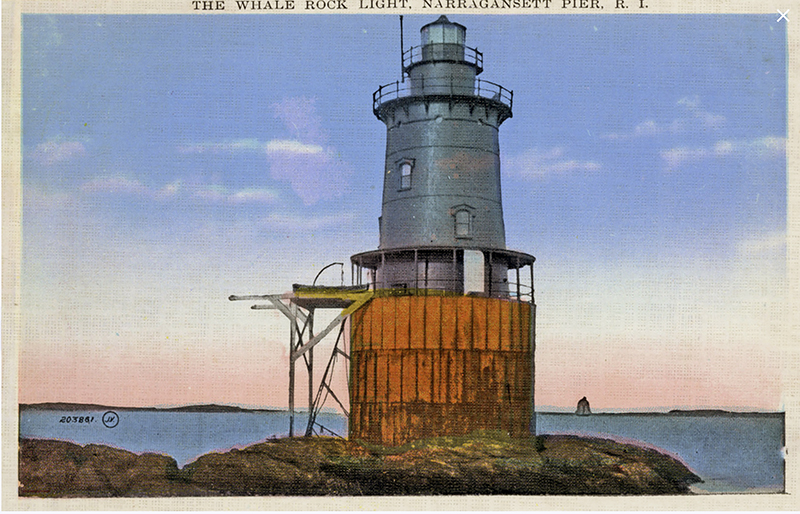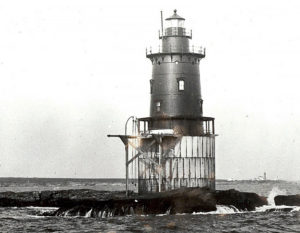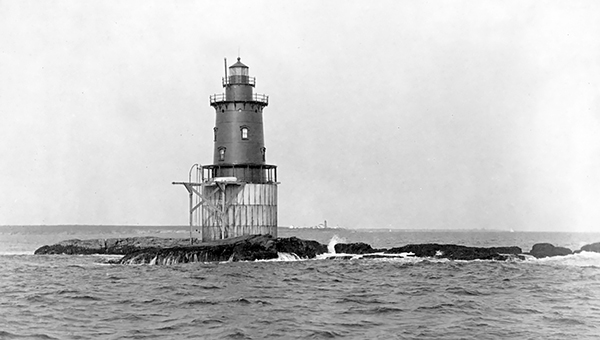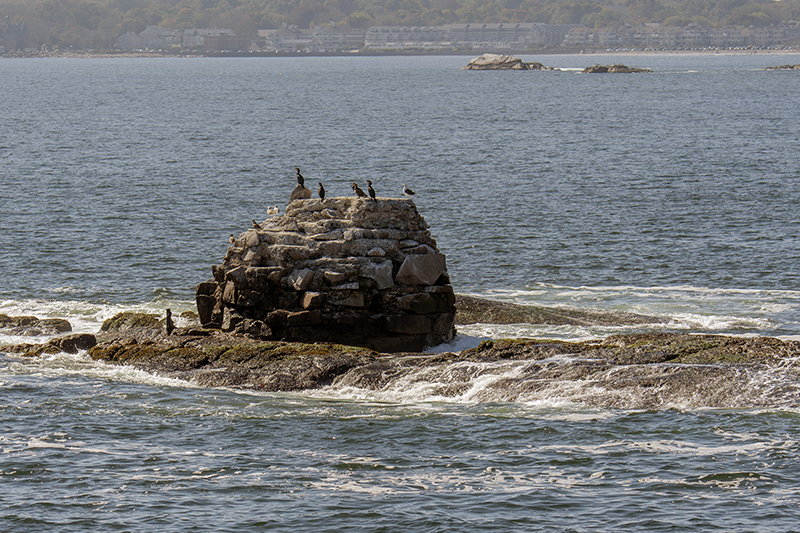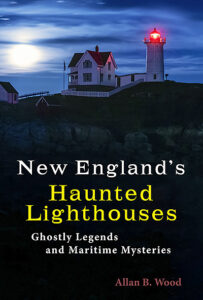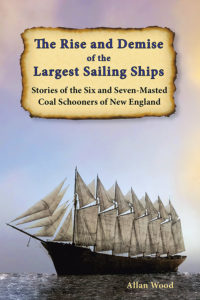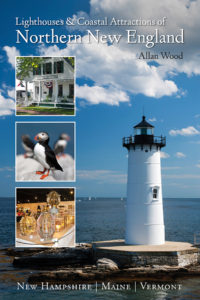Hurricane of 1938 Causes Tragedy and Destruction of Whale Rock Lighthouse in Rhode Island
Whale Rock, named for its appearance resembling a breaching whale, sat at the entrance to the West Passage of Narragansett Bay, a busy passage leading to the port of Providence, Rhode Island. The reef had claimed at least eight ships and six lives before the Lighthouse Board recommended building a light on the rock in 1872. It wasn’t until a large steamship named the Providence struck the rock in 1880 that Congress finally appropriated funds to build a lighthouse. It was finally completed in 1882 after many mishaps involving the workers being washed off the ledge from rogue waves.
Because Whale Rock Light was isolated a mile offshore and exposed to the many storms approaching Narragansett Bay, it was not considered a desirable post for its keepers. Between 1882 and 1909, Whale Rock Lighthouse had sixteen different keepers.
Walter Barge Eberle, father of six children, became the second assistant at the lighthouse in 1937. At fifteen, he ran away from home and lied about his age to enlist in the Navy, where he served for twenty years. Afterward, he worked at the Wrigley chewing gum factory in Newport and was elated to be appointed to serve at the lighthouse near the ocean. Whale Rock Light was built as a sparkplug light without the ability to house a family, so Eberle’s wife and children lived onshore at their family home in Newport. Eberle’s oldest son, Walter Jr., would sometimes go with his father and help to tend the light.
The early morning of September 21 showed no signs of the impending storm approaching. Keeper Dan Sullivan had left the lighthouse in his rowboat to get needed supplies on the mainland, leaving Eberle in charge of the light. The other assistant, Gustav Larson, was away on vacation.
While Keeper Sullivan was on shore, strong winds entered the harbor, and the seas began to churn, making it too challenging to return to the lighthouse in the little boat. He knew how difficult it was to land and secure the boat at the lighthouse in rough seas. The weather quickly deteriorated as giant waves broke all around the lighthouse. As the hurricane came into the bay, winds at 120 miles per hour with ferocious seas were causing a massive tidal surge, destroying everything in its path.
Walter B. Eberle had climbed to the top story of the 71-foot tower when the waves began to surround the lighthouse, thinking it was the safest place to ride out the storm. One can only imagine his terror in seeing waves breaking up to his level and higher around the lighthouse with constant force. The tidal surge and the heaving waters engulfed the lighthouse, tearing the Whale Rock Light’s top two stories away in one catastrophic moment. It is not known whether Eberle was killed instantly or drowned in the raging sea, as his body was never recovered.
It was a long, tension-filled night for Walter Eberle’s family, who were watching and waiting for news of their father and husband. Keeper Sullivan received the awful news first and had to get up the courage to phone the agonized family at about 5:30 the following morning. He mustered his strength to deliver a simple message: “The light is gone.”
Many days passed before the seas calmed enough to launch a boat to Whale Rock. The lighthouse and 40-year-old Walter Eberle were gone. The assistant keeper had been in the Lighthouse Service for one year.
Six weeks after the hurricane, G.C. Huxford of the Lighthouse Service was finally able to inspect the wreckage. In his report, he concluded that the top two stories of the lighthouse broke loose from the lower two floors and washed away. He believed Eberle was at the top of the tower, as most keepers had also done to ride out the storm. With the top half of the lighthouse gone and the brick lining weakened, the remaining two floors collapsed and were washed away by the tidal surge.
On November 9, 1938, the 2nd District Associate Engineer visited the remains of Whale Rock Lighthouse to determine the cause of its destruction. While examining its concrete base, he discovered the lighthouse wasn’t fastened to the base. He found that some bolts holding the lighthouse’s cast-iron plate were corroded, weakening its structural integrity. He reported that the constant pounding of the massive waves from the hurricane on September 21 jarred the corroded bolts loose, causing the top floors of the lighthouse to break off.
On September 21, 2008, 70 years after the hurricane, a plaque was dedicated to Walter Barge Eberle by the Friends of Whale Rock Light, the Beavertail Lighthouse Museum, and the Foundation for Coast Guard History. It resides in the Beavertail Museum in Jamestown, Rhode Island. It reads, “In honor and memory to U.S. Navy veteran and Light Keeper Walter B. Eberle. This brave sailor gave the last full measure of devotion to his duty to keep the light burning on September 21, 1938, when “The Great New England Hurricane of 1938” swept the Whale Rock Light Station into the Sea. Presented by The Foundation for Coast Guard History.” A lighted gong buoy now marks Whale Rock. Today, the crumbled remnants of the foundation are all that remain of the beacon.
Among the many deaths and losses of property caused by the 1938 hurricane, it was also responsible for the tragedies endured by the families of the keepers of Sandy Point Light, also referred to as Prudence Island Light, and Beavertail Light.
Note: The remains of this lighthouse can be viewed from Save the Bay Tours, on their Multi Lighthouse tour, offered during the summer months.
Books to Explore
New England’s Haunted Lighthouses:
Ghostly Legends and Maritime Mysteries
Uncover the mysteries of New England’s haunted lighthouses! Uncover ghostly tales of lingering keepers, victims of misfortune or local shipwrecks, lost souls, ghost ships, and more. Many of these accounts begin with actual historical events that later lead to unexplained incidents.
Immerse yourself in the tales associated with these iconic beacons!
The Rise and Demise of the Largest Sailing Ships:
Stories of the Six and Seven-Masted Coal Schooners of New England
In the early 1900s, New England shipbuilders constructed the world’s largest sailing ships amid social and political reforms. These giants were the ten original six-masted coal schooners and one colossal seven-masted vessel, built to carry massive quantities of coal and building supplies, and measured longer than a football field! This self-published book, rich in color and vintage images, showcases the historical accounts that accompanied these mighty ships.
Available also from bookstores in paperback, hardcover, and as an eBook for all devices.

Lighthouses and Coastal Attractions in Southern New England: Connecticut, Rhode Island, Massachusetts
Lighthouses and Coastal Attractions of Southern New England:
Connecticut, Rhode Island, and Massachusetts.
This 300-page book provides memorable human interest stories from each of the 92 lighthouses. You can explore plenty of indoor and outdoor coastal attractions, including whale-watching excursions, lighthouse tours, windjammer sailing tours, parks, museums, and even lighthouses where you can stay overnight. You’ll also find plenty of stories of hauntings around lighthouses.
Lighthouses and Coastal Attractions of Northern New England:
New Hampshire, Maine, and Vermont.
This 300-page book provides memorable human interest stories from each of the 76 lighthouses. It also describes and provides contact info for plenty of indoor and outdoor coastal attractions and tours. These include whale watching, lighthouse tours, unique parks, museums, and lighthouses where you can stay overnight. There are also stories of haunted lighthouses in these regions.
Copyright © Allan Wood Photography; do not reproduce without permission. All rights reserved.
Join, Learn, Support The American Lighthouse Foundation

